CADILLAC DEVILLE 1996 7.G Manual Online
Manufacturer: CADILLAC, Model Year: 1996, Model line: DEVILLE, Model: CADILLAC DEVILLE 1996 7.GPages: 354, PDF Size: 20.32 MB
Page 81 of 354
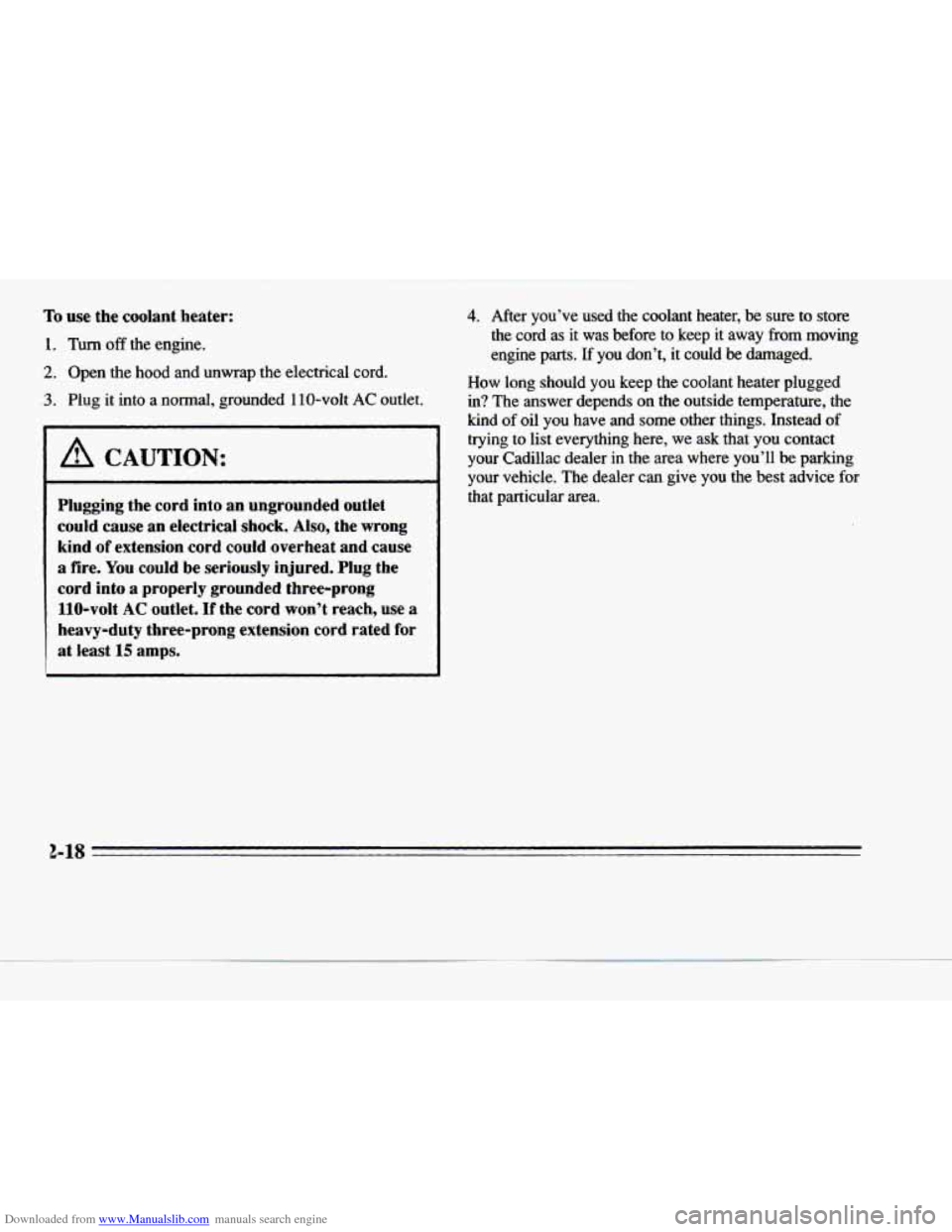
Downloaded from www.Manualslib.com manuals search engine To use the coolant heater:
1. Turn off the engine.
2. Open the hood and unwrap the electrical cord.
.3. Plug it into a nonnal, grounded 110-volt AC outlet.
I A CAUTION:
Plugging the cord into an ungrounded outlet
could cause
an electrical shock. Also, the wrong
kind
of extension cord could overheat and cause
a fire. You could be seriously injured. Plug the
cord into
a properly grounded three-prong
110-volt
AC outlet. If the cord won’t reach, use a
heavy-duty three-prong extension cord rated for
at least 15 amps.
4. After you’ve used the coolant heater, be sure to store
the cord as it was before to keep it away
from moving
engine parts. If you don’t, it could be damaged.
How long should you keep the coolant heater plugged
in? The answer depends on the outside temperature, the
kind
of oil you have and some other things. Instead of
trying
to list everything here, we ask that you contact
your Cadillac dealer in the area where you’ll be parking
your vehicle.
The dealer can give you the best advice for
that particular area.
2-18
-.
Page 82 of 354
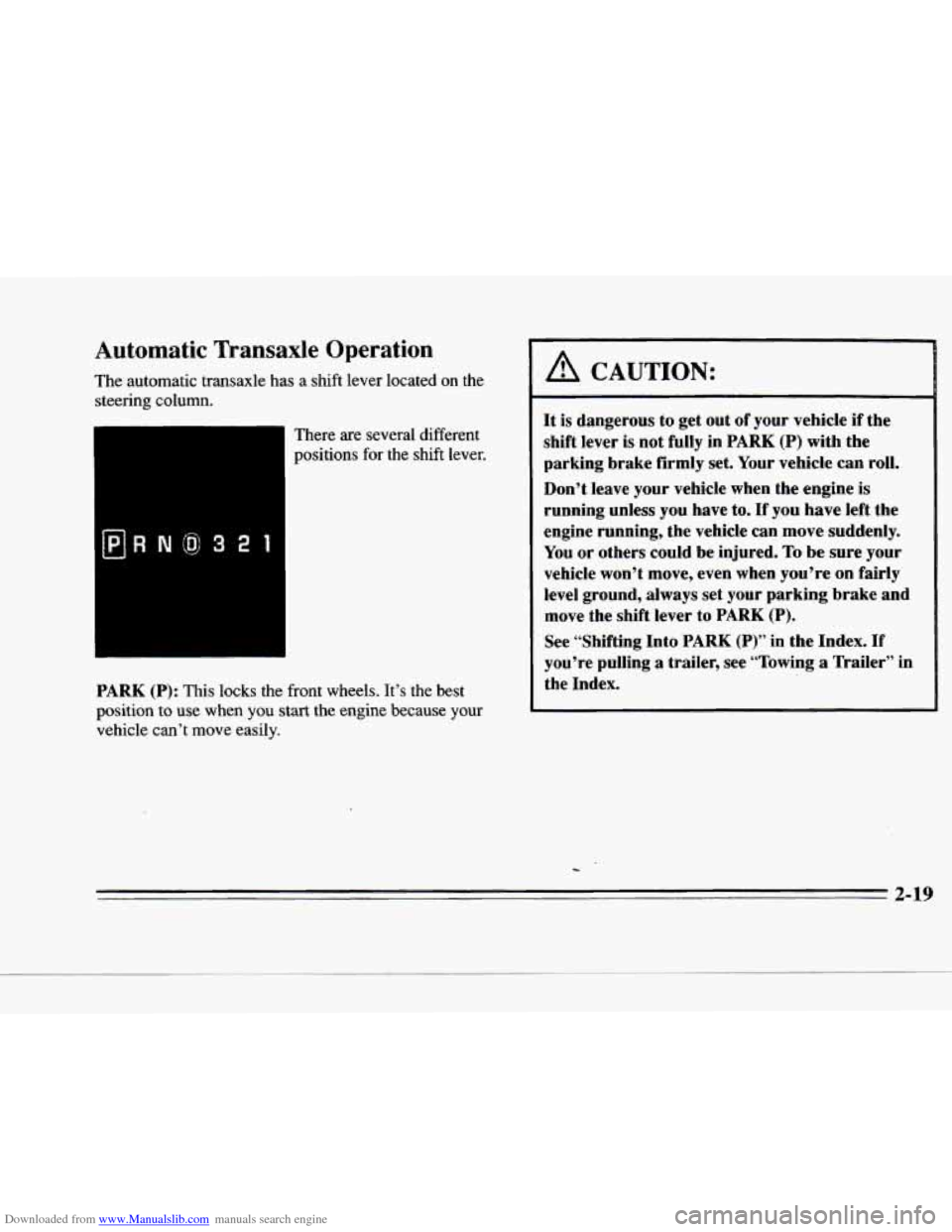
Downloaded from www.Manualslib.com manuals search engine Automatic Transaxle Operation
The automatic transaxle has a shift lever located on the
steering column.
There are several different
positions for the shift lever.
c PARK (P): This locks the front wheels. It’s the best
position to
use when you start the engine because your
vehicle can’t move easily.
A CAUTION:
It is dangerous to get out of your vehicle if the
shift lever
is not fully in PARK (P) with the
parking brake firmly set. Your vehicle can
roll.
Don’t leave your vehicle when the engine is
running unless you have to. If you have left the
engine running, the vehicle can move suddenly.
You or others could be injured.
To be sure your
vehicle won’t move, even when you’re on fairly
level ground, always set your parking brake and
move the
shift lever to PARK (P).
See “Shifting Into PARK (P)” in the Index. If
you’re pulling a trailer, see “Towing a Trailer” in
the Index.
2-19
Page 83 of 354
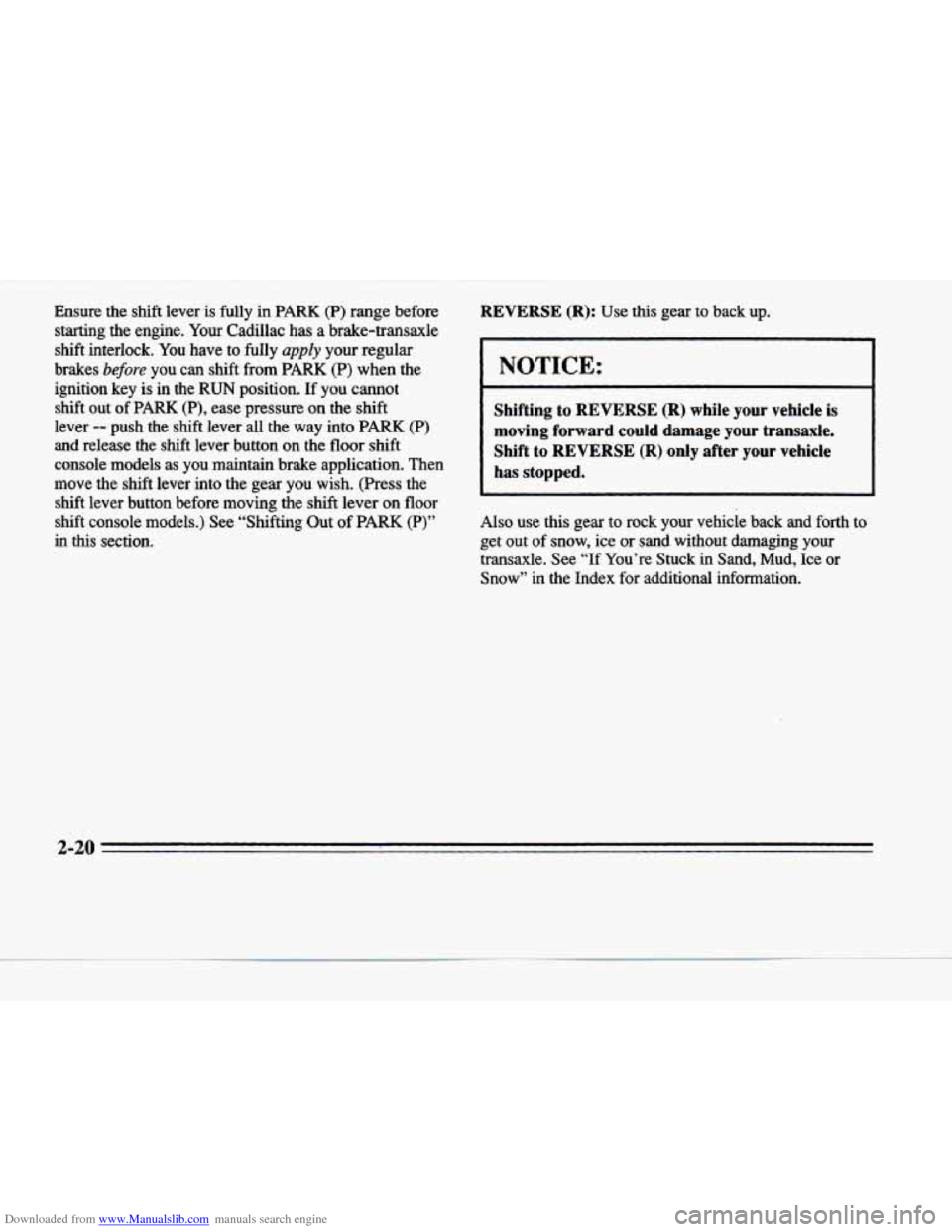
Downloaded from www.Manualslib.com manuals search engine Ensure the shift lever is fully in PARK (P) range before
starting the engine. Your Cadillac has a brake-transaxle
shift interlock. You
have to fully apply your regular
brakes
before you can shift from PARK (P) when the
ignition key is in
the RUN position. If you cannot
shift out of
PARK (P), ease pressure on the shift
lever
-- push the shift lever all the way into PARK (P)
and release the shift lever button on the floor shift
console models as
you maintain brake application. Then
move the shift lever into the gear
you wish. (Press the
shift lever button before moving the shift lever
on floor
shift console models.) See “Shifting Out
of PARK (P)”
in this section.
REVERSE (R): Use this gear to back up.
I NOTICE: 1 ~
Shifting to REVERSE (R) while your vehicle is
moving forward could damage your transaxle.
Shift to REVERSE
(R) only after your vehicle
has stopped.
Also use this gear to rock your vehicle back and forth to
get out of snow, ice
or sand without damaging your
transaxle. See
“If You’re Stuck in Sand, Mud, Ice or
Snow” in the Index for additional information.
2-20
Page 84 of 354
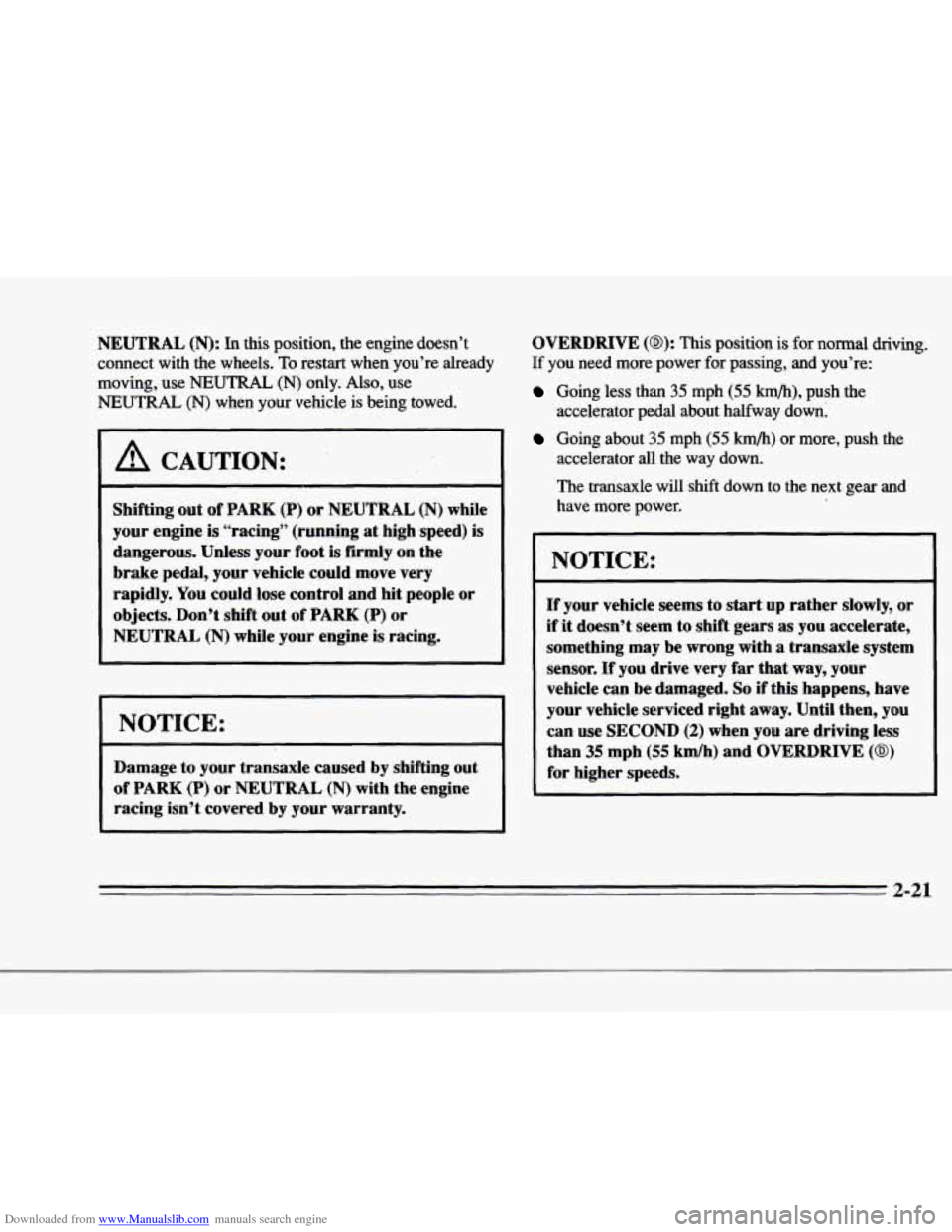
Downloaded from www.Manualslib.com manuals search engine r
r
Q
r
r
r
r
r
NEUTRAL (N): In this position, the engine doesn’t
connect with the wheels.
To restart when you’re already
moving, use
NEUTRAL (N) only. Also, use
NEUTRAL (N) when your vehicle is being towed.
I A CAUTION:
Shifting out of PARK (P) or NEUTRAL (N) while
your engine is “racing” (running at high ,speed) is
dangerous. Unless
your foot is firmly on the
brake pedal, your vehicle could move very
rapidly. You could lose control and hit people
or
objects. Don’t shift out of PARK (P) or
NEUTRAL (N) while your engine is racing.
I NOTICE:
Damage to your transaxle caused by shifting out
of PARK (P)
or NEUTRAL (N) with the engine
racing isn’t covered
by your warranty. OVERDRIVE
(a): This position is for normal driving.
If you need more power for passing, and you’re:
Going less than 35 mph (55 km/h), push the
accelerator pedal about haliivay down:
Going about 35 mph (55 km/h) or more, push the
accelerator all the way down.
The transaxle will shift down to the next gear and
have more power.
NOTICE:
If your vehicle seems to start up rather slowly, or
if it doesn’t seem to shift gears as you accelerate,
something may be wrong with
a transaxle system
sensor.
If you drive very far that way, your
vehicle can be damaged.
So if this happens, have
your vehicle serviced right
away. Until then, you
can use SECOND
(2) when you are driving less
than
35 mph (55 kdh) and OVERDRIVE (@)
for higher speeds.
2-21
Page 85 of 354
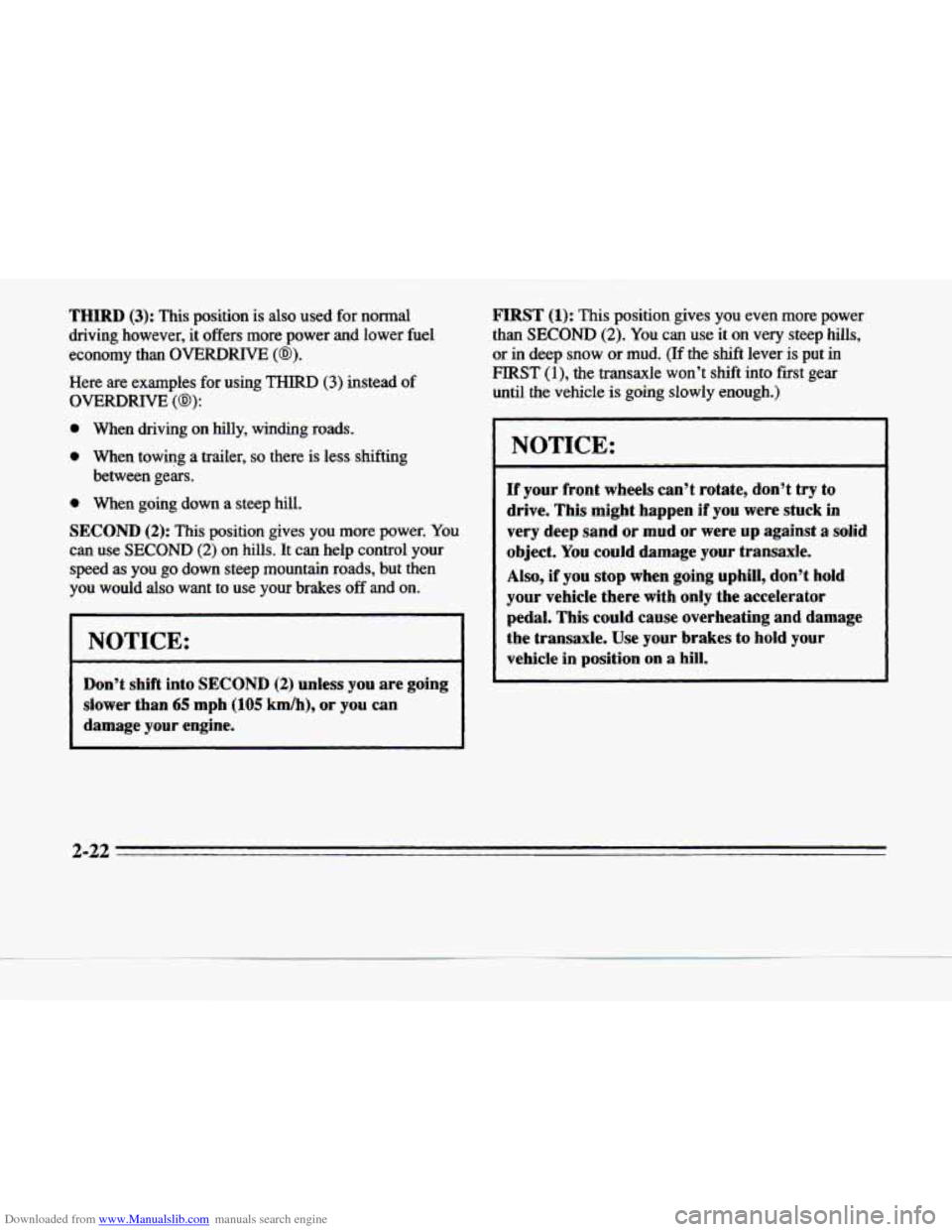
Downloaded from www.Manualslib.com manuals search engine THIRD (3): This position is also used for noma1
driving however,
it offers more power and lower fuel
economy than
OVERDRIVE (0).
Here are examples for using THIRD (3) instead of
OVERDRIVE (@):
0 When driving on hilly, winding roads.
0 When towing a trailer, so there is less shifting
between
gears.
0 When going down a steep hill.
SECOND (2): This position gives you more power. You
can use SECOND (2) on hills. It can help control your
speed
as you go down steep mountain roads, but then
you would also want
to use your brakes off and on.
I NOTICE:
~ ~~ ~~~ ~ ~~~~
Don’t shift into SECOND (2) unless you are going
slower than
65 rnph (105 kdh), or you can
damage your engine.
FIRST (1): This position gives you even more power
than
SECOND (2). You can use it on very steep hills,
or
in deep snow or mud. (If the shift lever is put in
FIRST (l), the transaxle won’t shift into first gear
until the vehicle is going slowly enough.)
I NOTICE:
~~
If your front wheels can’t rotate, don’t try to
drive. This might happen
if you were stuck in
very deep sand or mud or were up against a solid
object,
You could damage your transaxle.
Also, if you stop when going uphill, don’t hold
your vehicle there with only the accelerator
pedal. This could cause overheating and damage
the transaxle. Use your brakes
to hold your
vehicle in position on a hill.
-.
-4
-.
Page 86 of 354
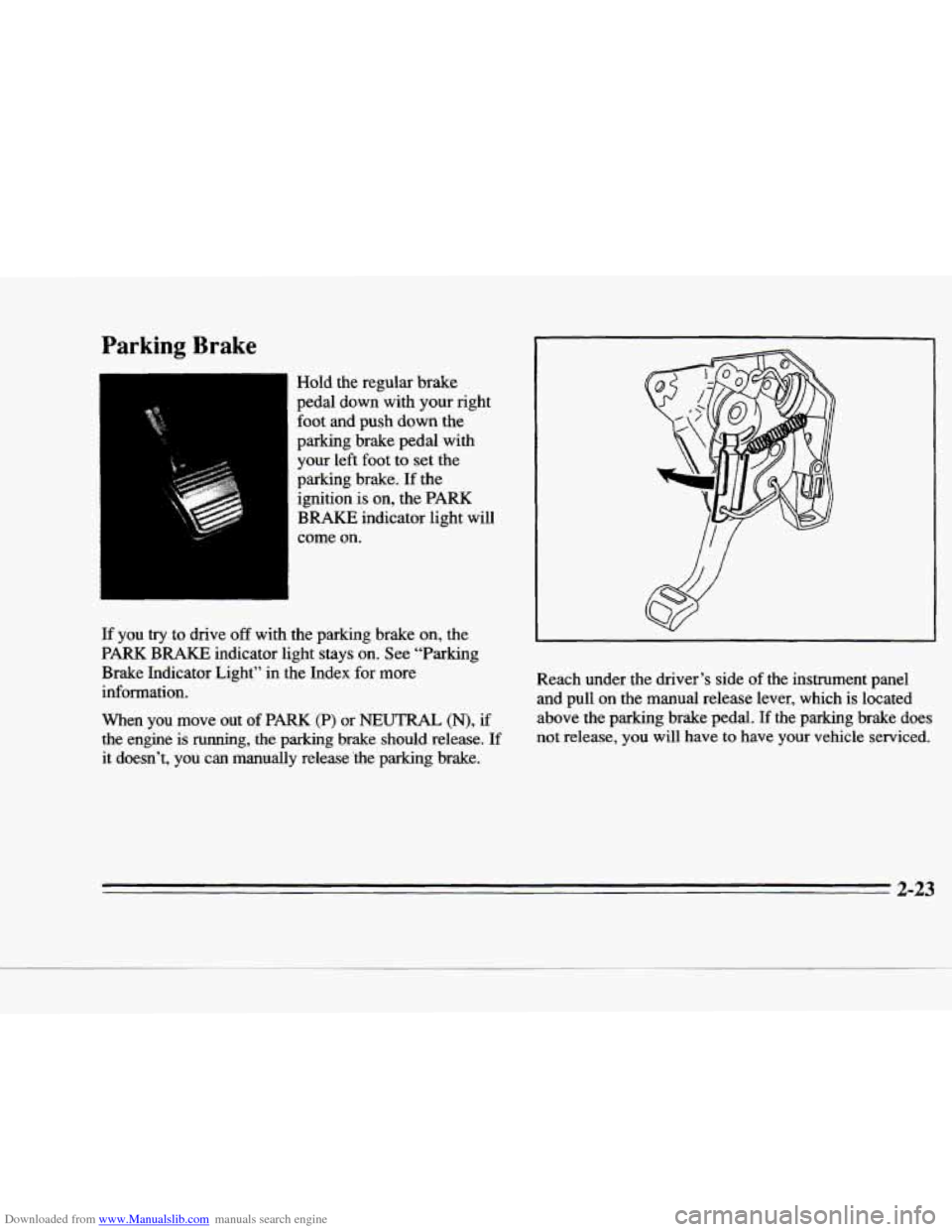
Downloaded from www.Manualslib.com manuals search engine F
c
Parking Brake
Hold the regular brake
pedal down with your right foot and push
down the
parking brake pedal with
your left foot to set the
parking brake. If the
ignition
is on, the PARK
BRAKE indicator light will
come
on.
If you try to drive off with the parking brake on, the
PARK
BRAKE indicator light stays on. See "Parking
Brake Indicator Light" in the Index for more
information.
When you move
out of PARK (P) or NEUTRAL (N), if
the engine is
running, the parking brake should release. If
it doesn't, you can manually release 'the parking brake. Reach under the driver's side
of the instrument panel
and pull on the manual release lever, which is located
above the parking brake pedal.
If the parking brake does
not release, you will have to have your vehicle serviced.
2-23
Page 87 of 354
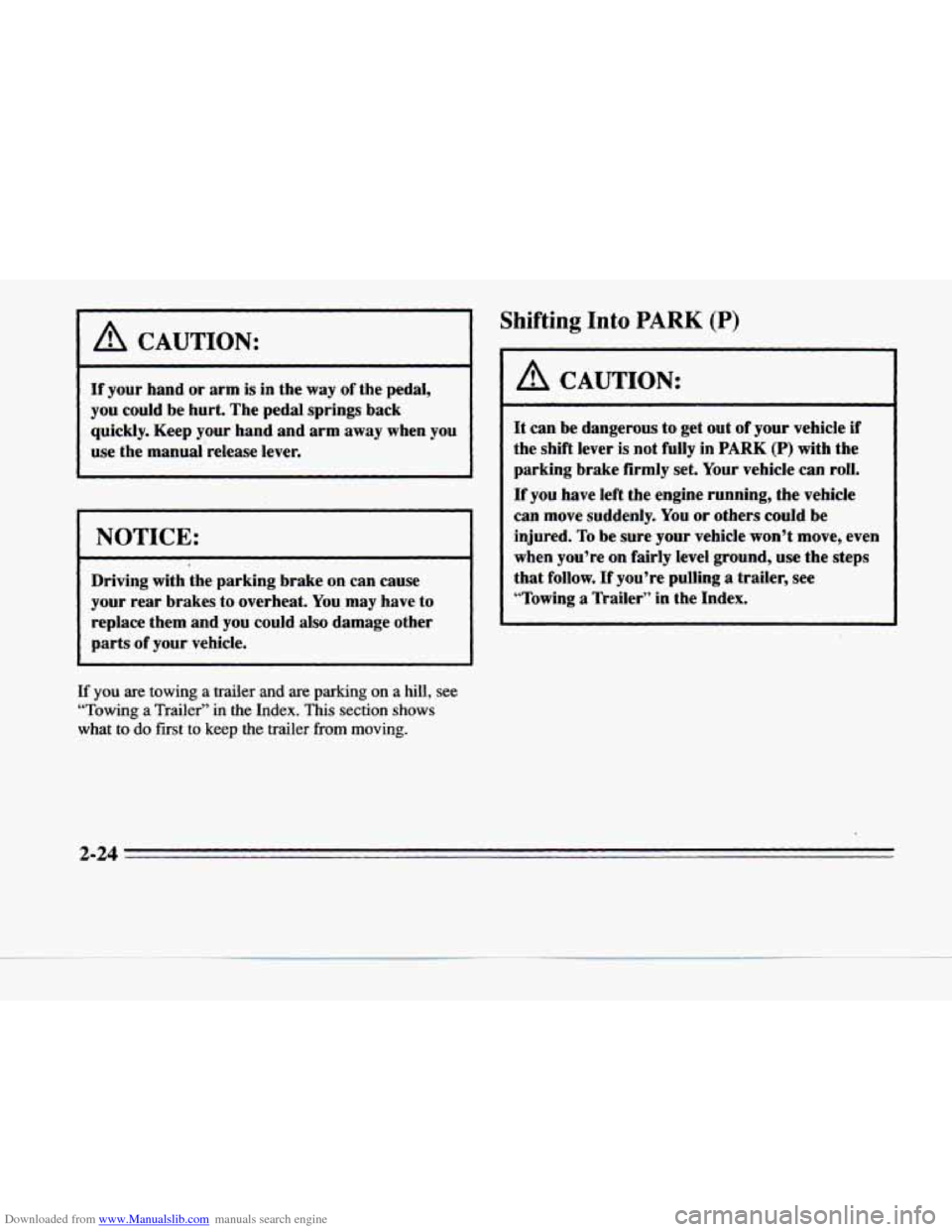
Downloaded from www.Manualslib.com manuals search engine I A CAUTION:
If your hand or arm is in the way of the pedal,
you could be hurt. The pedal springs back
quickly. Keep your hand and arm
away when you
use the manual’release lever.
I NOTICE:
Driving with the parking brake on can cause
your rear brakes to overheat. You may have to
replace them and you could also damage other
parts of your vehicle.
If you are towing a trailer and are parking on a hill, see
“Towing a Trailer”
in the Index. This section shows
what to do first to keep the trailer from moving.
Shifting Into PARK (P)
A CAUTION:
It can be dangerous to get out of your vehicle if
the shift lever
is not fully in PARK (P) with the
parking brake firmly set. Your vehicle can roll.
If
you have left the engine running, the vehicle
can move suddenly.
You or others could be
injured.
To be sure your vehicle won’t move, even
when you’re on fairly level ground, use the steps
that follow.
If you’re pulling a trailer, see
“Towing a Trailer” in the Index.
3 3A
Page 88 of 354
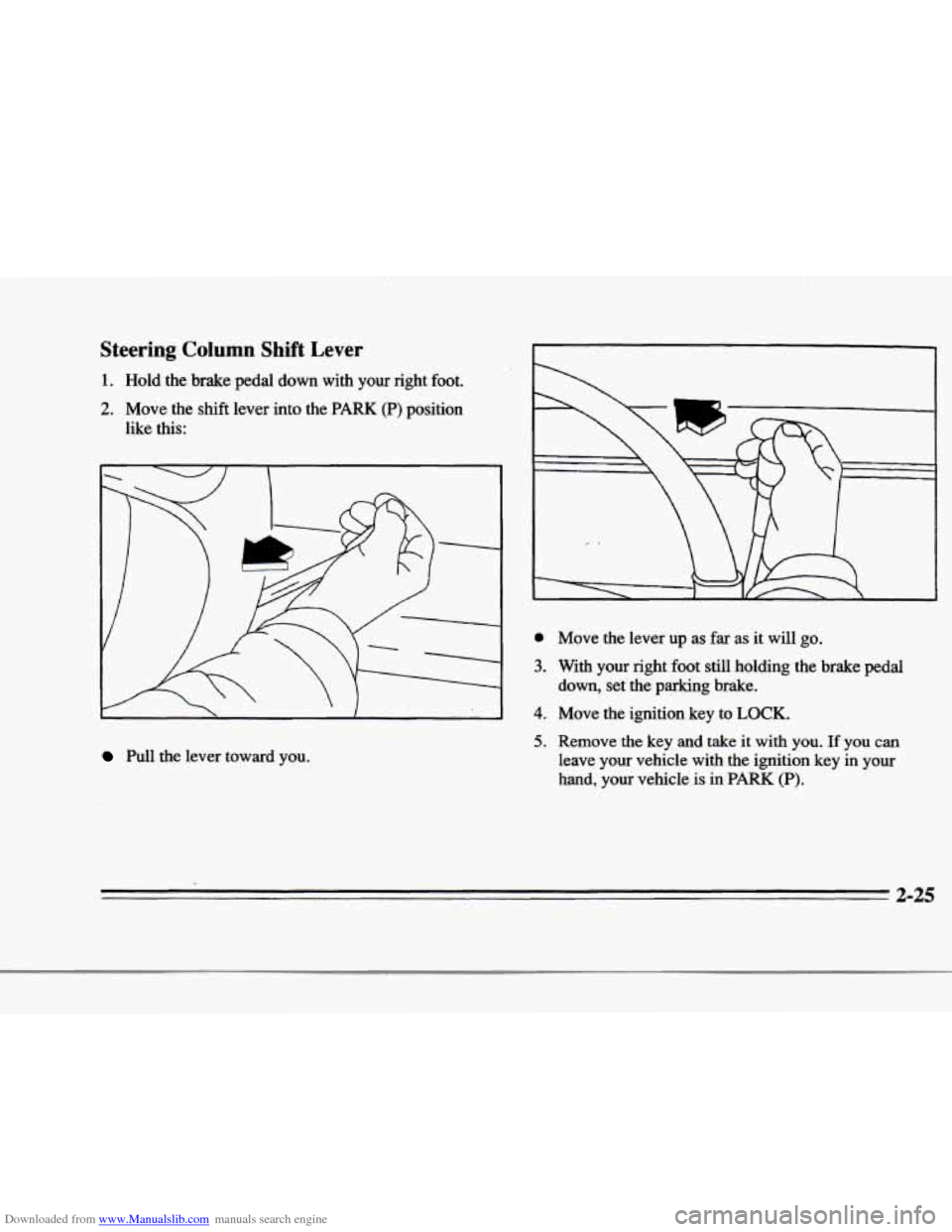
Downloaded from www.Manualslib.com manuals search engine f
r
r
r
r
Steering Column Shift Lever
1. Hold the brake pedal down with your right foot.
2. Move the shift lever into the PARK (P) position
like this:
Pull the lever toward you.
r
r .
e
3.
4.
5.
Move the lever up as far as it will go.
With your right foot still holding the brake pedal
down, set the parking brake.
Move the ignition key to
LOCK.
Remove the key and take it with you. If you can
leave
your vehicle with the ignition key in your
hand, your vehicle is
in PARK (P).
2-25
Page 89 of 354
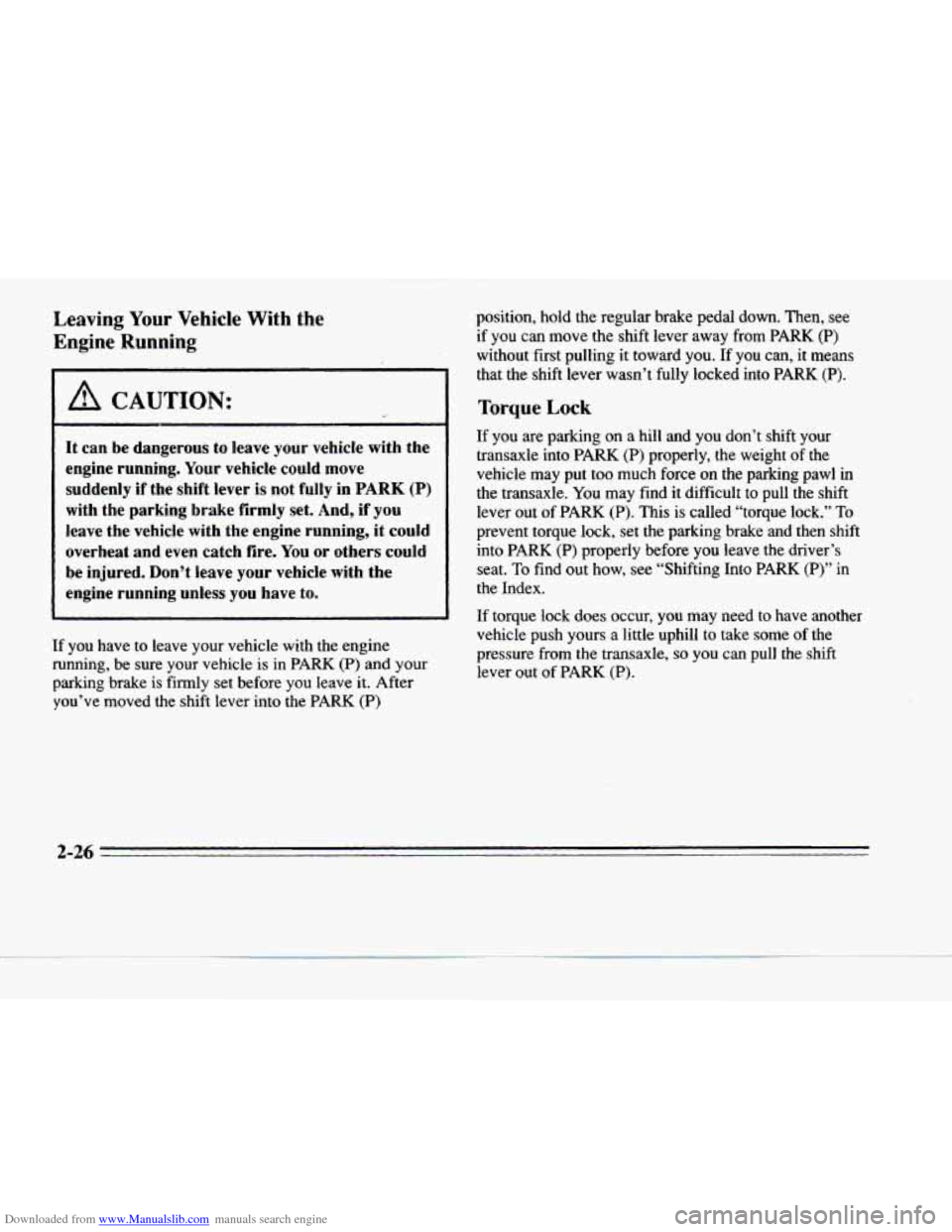
Downloaded from www.Manualslib.com manuals search engine Leaving Your Vehicle With the
Engine Running
I A CAUTION:
It can be dangerous to leave your vehicle with the
engine running. Your vehicle could move
suddenly if the shift lever
is not fully in PARK (P)
with the parking brake firmly set. And, if you
leave the vehicle with the engine running, it could
overheat and even catch fire.
You or others could
be injured. Don’t leave your vehicle with the
engine running unless
vou have to.
I
If you have to leave your vehicle with the engine
running, be sure your vehicle
is in PARK (P) and your
parking brake is firmly
set before you leave it. After
you’ve moved the shift lever into the PARK
(P)
position, hold the regular brake pedal down. Then, see
if you
can move the shift lever away from PARK (P)
without first pulling it toward you. If you can, it means
that the shift lever wasn’t fully locked into
PARK (P).
Torque Lock
If you are parking on a hill and you don’t shift your
transaxle into PARK
(P) properly, the weight of the
vehicle may put too much force on the parking pawl
in
the transaxle. You may find it difficult to pull the shift
lever out of
PARK (P). This is called “torque lock.” To
prevent torque lock, set the parking brake and then shift
into
PARK (P) properly before you leave the driver’s
seat.
To find out how, see “Shifting Into PARK (P)” in
the Index.
If torque lock does occur, you may need to have another
vehicle push yours a little uphill to take some
of the
pressure from the transaxle,
so you can pull the shift
lever out of PARK
(P).
2-26
r
Page 90 of 354
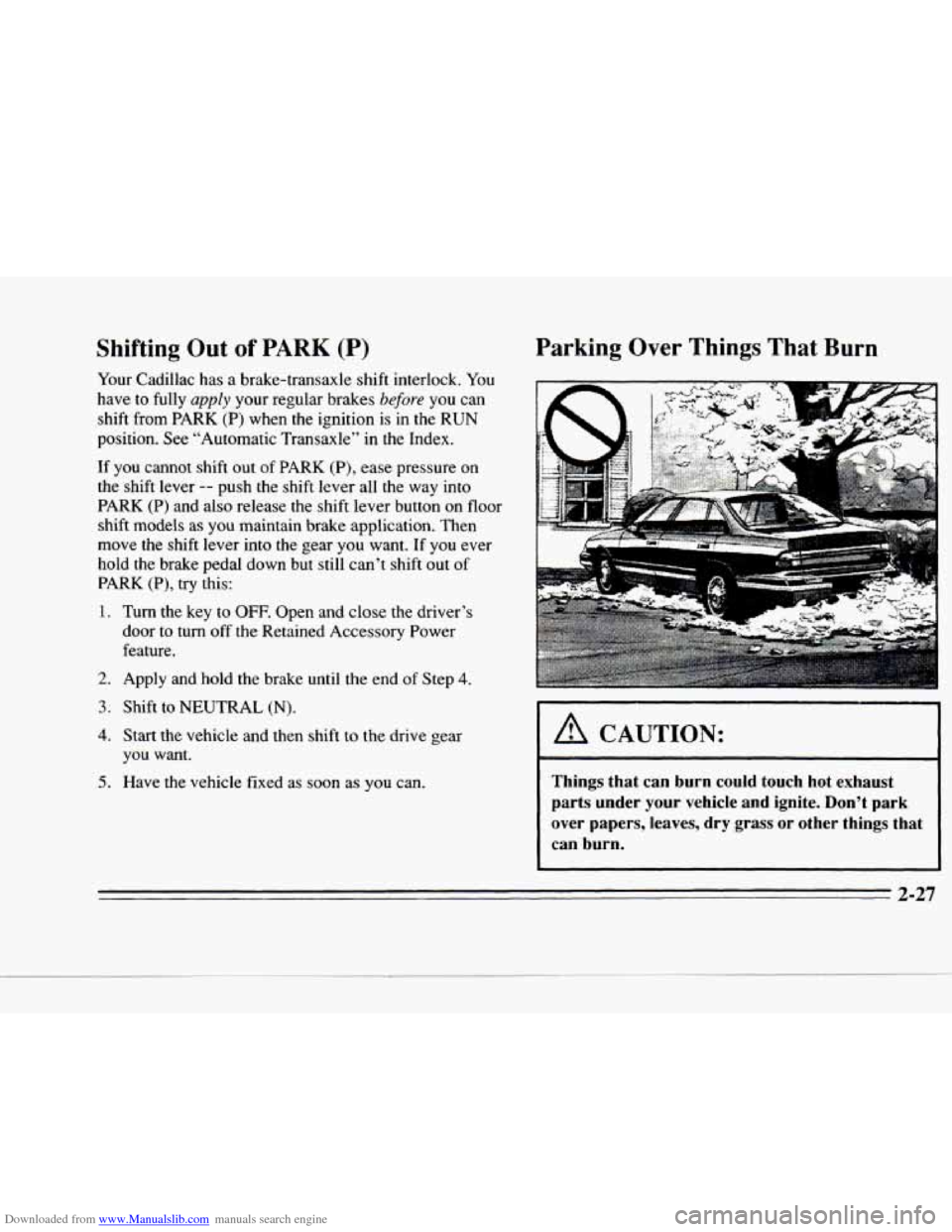
Downloaded from www.Manualslib.com manuals search engine c
c
c
Shifting Out of PARK (P)
Your Cadillac has a brake-transaxle shift interlock. You
have to fully apply your regular brakes before you can
shift from PARK
(P) when the ignition is in the RUN
position. See “Automatic Transaxle” in the Index.
If you cannot shift out of PARK (P), ease pressure on
the shift lever
-- push the shift lever all the way into
PARK (P) and also release the shift lever button on
floor
shift models as you maintain brake application. Then
move the shift lever into
the gear you want:If you ever
hold the brake pedal down but still can’t shift out
of
PARK (P), try this:
1. Turn the key to OFF. Open and close the driver’s
door
to turn off the Retained Accessory Power
feature.
2. Apply and hold the brake until the end of Step 4.
3. Shift to NEUTRAL (N).
4. Start the vehicle and then shift to the drive gear
5. Have the vehicle fixed as soon as you can.
you want.
Parking Over Things That Burn
I A CAUTION: I
Things that can
burn could touch hot exhaust
parts under your vehicle and ignite. Don’t park
over papers, leaves, dry grass or other things that can burn.
P